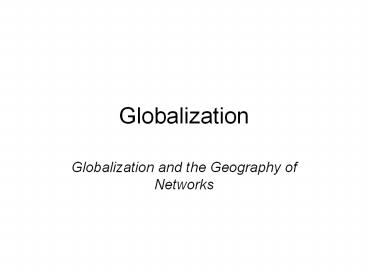Globalization - PowerPoint PPT Presentation
Title:
Globalization
Description:
Pop culture elements. Capital. FREE TRADE. Definition ... Main way popular culture elements are diffused. ( I.E., Music, McDonald's, Apple vs. IBM) ... – PowerPoint PPT presentation
Number of Views:34
Avg rating:3.0/5.0
Title: Globalization
1
Globalization
- Globalization and the Geography of Networks
2
Definition
- A set of processes that
- increase interactions
- deepen relationships
- heighten interdependence without regard to
country borders. - Does NOT include the free movement of people.
- A set of outcomes that are felt from these global
processes. - Unevenly distributed and manifested throughout.
3
Background Info.
- Its neither an inevitable nor an irreversible
set of processes. De Blij and Murphy - Understanding the origin and continued growth is
very hard to do. - There is no set pattern to its spread/effects.
4
Background Info. Cont
- The backbone of globalization is TRADE.
- Opened the doors for the dispersion of the
following, though it does not dictate it or
govern the dispersion exclusively - Cultural traits
- Ideas
- Pop culture elements
- Capital
5
FREE TRADE
- Definition
- Goods and services trade without interference of
government imposed costs.
6
Free Trade Encompasses
- International trade of goods without tariffs
(taxes on imports) or other trade barriers (e.g.,
quotas on imports) - International trade in services without tariffs
or other trade barriers - The free movement of labor between countries
- The free movement of capital between countries
- The absence of trade-distorting policies (such as
taxes, subsidies, regulations or laws) that give
domestic firms, households or factors of
production an advantage over foreign ones - Trade-distorting policies to enforce property
rights so as to ensure the above conditions
7
Free Trade cont
- Free trade raises the well-being of all
countries by inducing them to specialize their
resources in those goods they produce relatively
most efficiently in order to lower costs. -De
Blij and Murphy - As a result, a nations growth rate and access to
technology is increased. - This is known as the Washington Consensus
8
Timeline of Growth
- Stage One (G.1) (1492-1776)- The Age of
Exploration - Retrogression Period (1776-1815) due to the
Atlantic Wars - Stage Two (G.2) (1815-1947)- The Age of
Industrialization - Retrogression Period WWI, Great Depression, and
WWII - Stage Three (G.3) (1947- Present)- Post WWII
From Containment to the Free Market Competition
9
Anti-Globalization(Global Justice Movement)
- A social movement established to combat the
effects of globalization. - Believes that Core Periphery nations are
destroying semi-periphery and periphery national
economies to gain greater wealth. - Forcing them into foreign direct investment and
removing protections on domestic production. - Target WTO, W.Bank, and Intl Monetary Fund.
10
Anti-Globalization cont
- Rely heavily on protests and demonstrations to
spread messages. - Free trade is not free rather, it builds up a
global economic network that sends most benefits
to the core. -De Blij and Murphy
11
Role of Networks
- A set of interconnected nodes without a center.
- Types
- Financial
- Transportation
- Trade
- Government/Non-Government
- Education
- Media
- ETC
12
How Do Networks Work?
- They link everything that the dominant interests
view as valuable and discard what is not
valuable. - Networks have really flourished the in recent
years due to technology. - Some places more connected than others, thus
there is a spatial unevenness of globalization
and its outcomes.
13
Networks cont
- Ideally, networks should be horizontally
structured, have no center, and encourage
interaction amongst nodes.
14
Specific Types of Networks
- Development
- Networks set up by various organizations to
counter top down decision making by higher up
powers - Examples of Efforts
- Promote Participatory Development
- Locals participate in development decisions.
- Local Exchange Trading System
- People barter and trade services/goods for things
needed. (I.E., Vancouver Island and Berkeley)
15
Specific Types of Networks
- Media Networks
- Main way popular culture elements are diffused.
(I.E., Music, McDonalds, Apple vs. IBM) - Corporate Networks
- Vertical Integration vs. Horizontal Integration
- VI Corp that has ownership in a variety of
points along the production and consumption of a
commodity chain. (Time Warner) - HI When the consumer spends, the money is going
towards the same parent co. (Macys) - Global retail can be very damaging to small,
locally owned businesses.
16
Networks The Effects of Time-Space Compression
- Definition
- Establishes that certain places are more
interconnected than ever through communication
and transportation networks. (I.E., Global cities
in core periphery) - Periphery nations are farther removed than ever.
- TSC is hugely impacted by Technology.
- How does technology create such a great divide
between the periphery and the core?
17
Effects of TSC on Global Cities
- Allows an individual to see the network of
interactions that these cities maintain in terms
of globalized processes. - Finances
- Media
- Air Travel
- Technology
18
TSC on Global Cities cont
- Most globalized cities
- London
- New York
- Tokyo
19
The Globalization of McDonalds
20
(No Transcript)
21
(No Transcript)































